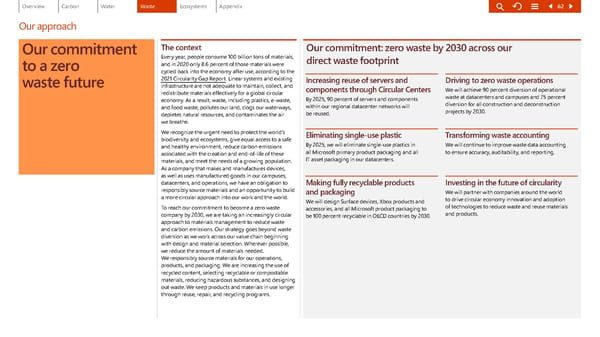Our approach Our commitment to a zero waste future The context Every year, people consume 100 billion tons of materials, and in 2020 only 8.6 percent of those materials were cycled back into the economy after use, according to the 2021 Circularity Gap Report . Linear systems and existing infrastructure are not adequate to maintain, collect, and redistribute materials effectively for a global circular economy. As a result, waste, including plastics, e-waste, and food waste, pollutes our land, clogs our waterways, depletes natural resources, and contaminates the air we breathe. We recog nize the urgent need to protect the world’s biodiversity and ecosystems, give equal access to a safe and healthy environment, reduce carbon emissions associated with the creation and end-of-life of these materials, and meet the needs of a growing population. As a company that makes and manufactures devices, as well as uses manufactured goods in our campuses, datacenters, and operations, we have an obligation to responsibly source materials and an opportunity to build a more circular approach into our work and the world. To reach our commitment to become a zero waste company by 2030, we are taking an increasingly circular approach to materials management to reduce waste and carbon emissions. Our strategy goes beyond waste diversion as we work across our value chain beginning with design and material selection. Wherever possible, we reduce the amount of materials needed. We responsibly source materials for our operations, products, and packaging. We are increasing the use of recycled content, selecting recyclable or compostable materials, reducing hazardous substances, and designing out waste. We keep products and materials in use longer through reuse, repair, and recycling programs. Our com mitment: zero waste by 2030 across our direct waste footprint Increasing reuse of servers and components through Circular Centers By 2025, 90 percent of servers and components within our regional datacenter networks will be reused. Eliminating single-use plastic By 2025, we will eliminate single-use plastics in all Microsoft primary product packaging and all IT asset packaging in our datacenters. Making fully recyclable products and packaging We will design Surface devices, Xbox products and accessories, and all Microsoft product packaging to be 100 percent recyclable in OECD countries by 2030. Driving to zero waste operations We will achieve 90 percent diversion of operational waste at datacenters and campuses and 75 percent diversion for all construction and deconstruction projects by 2030. Transforming waste accounting We will continue to improve waste data accounting to ensure accuracy, auditability, and reporting. Investing in the future of circularity We will partner with companies around the world to drive circular economy innovation and adoption of technologies to reduce waste and reuse materials and products. 62
 Environmental Sustainability Report | Microsoft Page 61 Page 63
Environmental Sustainability Report | Microsoft Page 61 Page 63